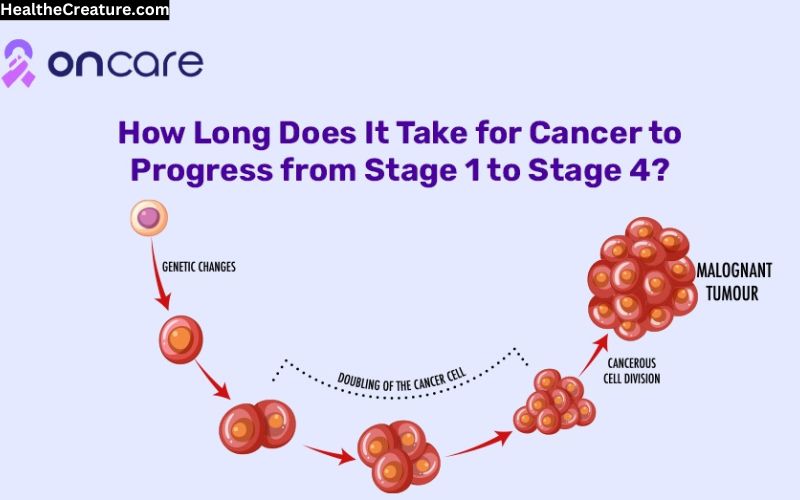Cancer is a prominent disease with a high mortality rate. It is a group of diseases caused by genetic mutations that result in abnormal or uncontrolled growth of cells. Various research and advances have been made to understand and treat cancer, which is truly commendable. However, cancer can progress in diverse ways, and predicting a timeline for its progression is difficult. Hence, monitoring its spread becomes a crucial aspect of personalized treatment in patients. At Oncare, our team of oncologists diagnoses your current stage of cancer and customizes your treatment accordingly for quick recovery.
While it is complex to provide a specific timeline for the progression, understanding some major components of cancer can be helpful. This article will help you get an overview of the stages of cancer, highlighting the factors that influence its progression.
Stages of Cancer: An Overview of Progression
Understanding the stages of cancer is crucial in determining how it progresses. Therefore, let us delve into each stage of cancer.
Stage 0
In this stage, abnormal but non-invasive cells are found in their original form. They have not spread beyond the place of their origin. There are a few visible symptoms at this stage, and it is highly curable.
Stage 1
It is the early stage of cancer where the tumor is small and just starting to grow. It is mostly confined to the place of its origin and is referred to as localized cancer. In this stage, the spread to nearby lymph nodes and other tissues has not started. In Stage 1, the chances of survival are high as the prognosis is effective.
Stage 2
In Stage 2, cancer growth is relatively advanced. The cancer is larger than in Stage 1 and has started to spread to nearby lymph nodes. Though other parts of the body are not yet affected by the cancerous cells, treating Stage 2 cancer is often complex. However, treatments such as chemotherapy or hormone therapy can reduce the risk of recurrence.
Stage 3
In this stage, cancer becomes more extensive. The cancer has comparatively grown larger than before, affecting nearby lymph nodes and other surrounding tissues. As it is a more advanced stage of cancer, it requires an aggressive approach to treatment, and the prognosis can vary more significantly than in earlier stages. However, the outcome of the treatment is less predictable in this stage.
Stage 4
Stage 4 indicates that cancer has spread to distant tissues or organs from its designated origin. This stage of cancer is called Metastatic Cancer, and it can commonly affect the lungs, liver, bones, and other vital body parts. Cancer cells form new tumors by attacking healthy tissues as they travel to distant body parts through the lymphatic system or bloodstream. Treatment of Stage 4 cancer is more challenging and is often focused on management rather than cure.
Importance of Cancer Staging
The cancer staging system offers critical information on cancer within the body. The stages are classified by doctors using the TNM system, which is the most widely used staging system for cancer. This staging helps to determine the spread of cancerous cells, their location, and to what extent they are curable. Doctors classify cancer into different stages according to its type. The letter T describes the size of the primary tumor, N refers to the spread of cancer to the lymph nodes, and M indicates whether the cancer has spread to distant parts of the body. In the case of blood cancer, staging is different from that of solid tumors.
Knowing the stage of cancer can help predict prognosis and chances of successful treatment. It is important that the staging is accurate. It gives a clear understanding of the cancer stage and leads to progress in valuable research. Furthermore, it provides accurate documentation of the disease and allows evaluation of cancer. Hence, using the TNM staging system provides a wide range of treatment strategies to healthcare professionals. Equipped with advanced facilities, Oncare is dedicated to offering accurate diagnoses and effective therapies for cancer patients of all stages.
How Fast Can Cancer Grow?
The progression of cancer is non-linear, and it is often hard to predict how fast it can grow. It varies according to the type, stage, grade, and other individual factors unique to a cancer patient. However, let’s understand how cancer cells can grow and spread throughout the surrounding tissues within the body.
Blocking the Blood Vessels
As cancerous cells extend beyond their original form, they move through the surrounding tissues that are easier to penetrate. They start growing within the tissues and take the form of a tumor. While the tumor grows, it can compress or invade the blood vessels and start spreading more. As the blood vessels are affected, healthy tissues do not receive a sufficient amount of oxygen, and they die. Hence, it becomes easier for the cancer to grow bigger in these tissues.
Releasing Enzymes
Healthy cells release enzymes to kill viruses and bacteria that invade our body, which is a part of natural healing. In cancer, certain enzymes are overexpressed. Certain enzymes, like glycolytic enzymes and lactate dehydrogenase, help cancer cells adapt to their metabolism. This makes it easier for cancer cells to spread faster through tissues.
Factors That Influence Cancer Progression
There are a lot of factors that may lead to cancer progression, and understanding them is essential.
Genetic and Epigenetic Alterations
Both genetic and epigenetic alterations play a vital role in cancer progression. Genetic mutations in oncogenes lead to the uncontrolled growth of cells that promote cancer progression. Similarly, epigenetic alteration disrupts DNA methylation, which affects the functioning of DNA repair genes. Hence, both genetic and epigenetic alterations promote growth in cancer cells, leading to genomic instability and metastasis. Understanding the effects of genetic and epigenetic mutations and monitoring them is important for strategic treatment. At Oncare, our oncologists are committed to providing patients with valuable information and ensuring consistent support to help them minimize the duration of cancer progression.
Cancer Type
Cancer types are a significant factor in cancer progression. The progression of cancer may vary depending on the type. Depending on their type, cancer can be aggressive and progress faster in some cases, while some cancers have slower growth. For example, cancers like acute leukemia and lung cancer tend to progress rapidly, while others like prostate cancer may grow slowly. Because of their nature of progression, the treatments that might work for a certain cancer won’t be effective on another. Hence, as challenging as it may seem, understanding the type of cancer in a patient becomes crucial for medical professionals. Incorporating targeted immunotherapy can lead to improved outcomes for some types of cancer.
Tumor Microenvironment
Another crucial factor in cancer progression is the tumor microenvironment. The tumor microenvironment is a cluster of immune cells, blood vessels, and fibroblasts that create an ecosystem surrounding the tumor, often supporting its growth. It can lead to the growth and spread of the tumor by providing nutrients. Treatment with immunotherapy is applied to target the patient’s immune cells and enhance the effectiveness of treatment.
Environment
Your environment can also be a major factor in cancer mutation. While poor air quality and pollutants can damage your lung tissues, excessive exposure to UV rays and ionizing radiation during chemotherapy can cause a high risk of cancer. It may develop over time and can lead to lung and skin cancer.
Lifestyle
Your lifestyle can determine your health. It is similar in the case of cancer, as certain lifestyle factors can lead to cancer progression. Some crucial factors are smoking, consumption of alcohol, poor diet, and physical inactivity. Therefore, living a healthy and balanced lifestyle can lead to better possibilities for treatment outcomes in cancer patients.
Treatment Response
While the above factors play a major role in the progression of cancer, access to effective treatment can also contribute to slowing or accelerating the progression. As early diagnosis and treatment help slow the progression, delaying the same can lead to adverse effects and speed up the progression of cancer. Hence, the response to treatment has a significant impact on the progression of cancer.
Conclusion
To summarize, the progression of cancer from Stage 1 to Stage 4 is complex and is shaped by various factors and types. Its journey from a localized disease to metastasis represents a life-threatening development of this condition. Using standardized and advanced methods like TNM staging can offer a detailed assessment and suitable treatment approaches for managing cancer progression. From initial prognosis to personalized treatment plans, Oncare aims to provide the best possible outcomes for cancer patients. No matter the stage you’re in, we’re here to care for you at every step of your cancer treatment and recovery journey.
FAQs
- How quickly can cancer develop from Stage 1 to Stage 4?
The length of time that cancer takes to progress from Stage 1 to Stage 4 varies with the aggressiveness of the cancer and its type. Certain cancers, such as lung or pancreatic cancer, can progress very rapidly in a matter of months. Others will take several years. An example is one form of lung cancer known as adenocarcinoma, which tends to develop more slowly than other forms.
- What determines how rapidly cancer spreads?
A number of things may influence how fast cancer develops. The grade and type of cancer are important—a high-grade tumor will generally develop more rapidly. Mutations in cancer cells’ genes may also make them grow and metastasize more quickly. The environment within the tumor, such as the cells and blood vessels around it, can support tumor growth. Finally, the general health of a person, particularly a compromised immune system, can facilitate cancer spreading.
- Can early detection of cancer prevent it from advancing?
Yes. When cancer is detected early, it’s frequently simpler to treat. In the early stages, it typically hasn’t spread very far. Routine follow-up visits and noticing new symptoms can help detect cancer early and prevent it from reaching Stage 4.
- What does the TNM system do for cancer staging?
Oncologists tend to use the TNM system to determine the extent of the spread of cancer. T represents the tumor size, N indicates the involvement of lymph nodes, and M represents the spread of cancer to distant parts of the body. It aids in directing treatment and providing a better understanding of what is to be expected.
- Are some cancers quicker than others?
Yes, certain cancers spread and grow more quickly. Small cell lung cancer and certain cancers of the pancreas are ones that will spread rapidly. Others, such as prostate cancer, can grow very slowly and may not require immediate treatment.

